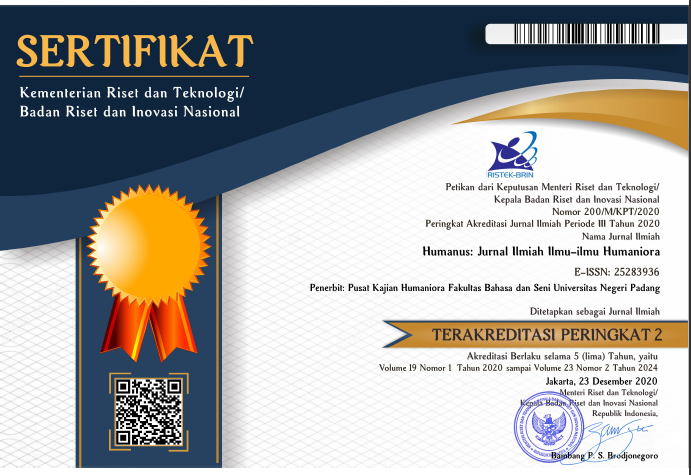Parentinguistic: A Form and Function of Compliment Expression
 ),
), (1) UIN Raden Mas Said Surakarta
 Corresponding Author
Corresponding Author
Copyright (c) 2025 Kurniawan Kurniawan
DOI : https://doi.org/10.24036/humanus.v24i1.124679
Full Text:
 Language : en
Language : en
Abstract
Keywords
References
Astuti, D., & Wijayanto, A. (2017). Compliment Expressions and Compliment Responses Used By Characters In “Little Women” Novel (Doctoral dissertation, Universitas Muhammadiyah Surakarta).
Austin, J. L. (1975). How to do things with words. Oxford university press.
Bernicot, J., Comeau, J., & Feider, H. (1993). Speech acts by mother and child: Determining their nature and form. European journal of psychology of education, 8(1), 35-50.
Chandra, A. A. (2019). Peranan Pola Pengasuhan terhadap Pemerolehan Bahasa pada Anak: Sebuah Kajian Psikolinguistik. Literasi: Jurnal Ilmiah Pendidikan Bahasa, Sastra Indonesia dan Daerah, 8(2), 75-83.
Chaer, A., & Agustina, L. (2010). Sosiolinguistik: perkenalan awal. Penerbit PT Rineka Cipta.
Fernald, A., Taeschner, T., Dunn, J., Papousek, M., de Boysson-Bardies, B., & Fukui, I. (1989). A cross-language study of prosodic modifications in mothers' and fathers' speech to preverbal infants. Journal of child language, 16(3), 477-501.
Golinkoff, R. M., Can, D. D., Soderstrom, M., & Hirsh-Pasek, K. (2015). (Baby) talk to me: the social context of infant-directed speech and its effects on early language acquisition. Current Directions in Psychological Science, 24(5), 339-344.
Gunawan, G. (2016). Gambaran Perkembang Bicara dan Bahasa Anak Usia 0-3 Tahun. Sari Pediatri, 13(1), 21-5.
Herbert, R. K. (1989). The ethnography of English compliments and compliment responses: A contrastive sketch. Contrastive pragmatics, 3-35.
Holmes, J. (1986). Compliments and compliment responses in New Zealand English. Anthropological linguistics, 485-508.
Holmes, J. (1988). Paying compliments: A sex-preferential politeness strategy. Journal of pragmatics, 12(4), 445-465.
Holmes, J. (2013). Women, men and politeness. Routledge.
Kholifah, S. N. (2021). Compliments and responses used by female English teachers and students at Nurul Jadid Islamic Boarding School (Doctoral dissertation, Universitas Islam Negri Maulana Malik Ibrahim).
Kokkinaki, T., Vasdekis, V. G., & Devouche, E. (2020). Maternal and paternal infant-directed speech to girls and boys: An exploratory study. European Journal of Developmental Psychology, 17(3), 379-414.
Mandalasari, M., & Hamzah, H. (2018). Compliment strategy and topics based on gender differences by Indonesian Idol Judges 2018. English Language and Literature, 7(4).
Mulqiah, Z., Santi, E., & Lestari, D. R. (2017). Pola Asuh Orang Tua Dengan Perkembangan Bahasa Anak Prasekolah (Usia 3-6 Tahun). Dunia Keperawatan: Jurnal Keperawatan Dan Kesehatan, 5(1), 61-67.
Purnama, S., & Hidayati, L. (2020). Pengasuhan Anak Usia Dini Dalam Hikayat Indraputra. Jurnal Obsesi: Jurnal Pendidikan Anak Usia Dini, 4(2), 520-542.
Rabain-Jamin, J., & Sabeau-Jouannet, E. (1997). Maternal speech to 4-month-old infants in two cultures: Wolof and French. International Journal of Behavioral Development, 20(3), 425-451.
Rahardi R. Kunjana. 2005. Pragmatik. Jakarta: Erlangga.
Rahmaningrum, A., & Fauziah, P. (2020). Peran Guru pada Pengasuhan Anak dari Keluarga Tenaga Kerja Indonesia. Jurnal Obsesi: Jurnal Pendidikan Anak Usia Dini, 5(2), 1282-1292.
Rowe, M. L. (2012). A longitudinal investigation of the role of quantity and quality of child‐directed speech in vocabulary development. Child development, 83(5), 1762-1774.
Trevarthen, C. (2016). From the intrinsic motive pulse of infant actions to the life time of cultural meanings. In Philosophy and psychology of time (pp. 225-265). Springer, Cham.
Trevarthen, C., & Delafield-Butt, J. (2017). Intersubjectivity in the imagination and feelings of the infant: Implications for education in the early years. In Under-three year olds in policy and practice (pp. 17-39). Springer, Singapore.Reisland, 2012)
Wolfson, N. (1989). The social dynamics of native and nonnative variation in complimenting behavior. In The dynamic interlanguage (pp. 219-236). Springer, Boston, MA.
Wolfson, N., & Judd, E. (1983). Sociolinguistics and Language Acquisition. Newbury House Publishers, Inc, Rowley, MA 0l969.
Wolfson, N., & Manes, J. (1980). The compliment as a social strategy. Research on Language & Social Interaction, 13(3), 391-410.
Yayuk, R. (2016). TINDAK EKSPRESIF PUJIAN DALAM BAHASA BANJAR (Expressive Speech Acts Compliment the Banjar Language). Jurnal Ilmiah Kebahasaan Dan Kesastraan: TOTOBUANG. https://doi.org/https://doi.org/10.26499/ttbng.v4i2.25
Yule, G., & Widdowson, H. G. (1996). Pragmatics. Oxford university press.
 Article Metrics
Article Metrics
 Abstract Views : 56 times
Abstract Views : 56 times
 PDF Downloaded : 13 times
PDF Downloaded : 13 times
Refbacks
- There are currently no refbacks.
Copyright (c) 2025 Kurniawan Kurniawan

This work is licensed under a Creative Commons Attribution-NonCommercial 4.0 International License.










